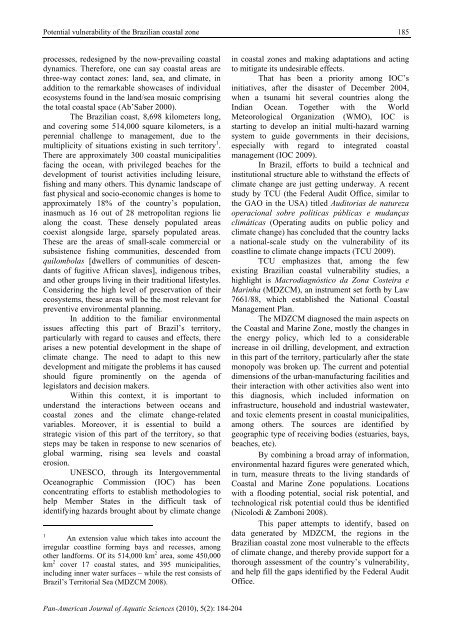Download full issue - PanamJAS
Download full issue - PanamJAS
Download full issue - PanamJAS
- No tags were found...
You also want an ePaper? Increase the reach of your titles
YUMPU automatically turns print PDFs into web optimized ePapers that Google loves.
Potential vulnerability of the Brazilian coastal zone185processes, redesigned by the now-prevailing coastaldynamics. Therefore, one can say coastal areas arethree-way contact zones: land, sea, and climate, inaddition to the remarkable showcases of individualecosystems found in the land/sea mosaic comprisingthe total coastal space (Ab’Saber 2000).The Brazilian coast, 8,698 kilometers long,and covering some 514,000 square kilometers, is aperennial challenge to management, due to themultiplicity of situations existing in such territory 1 .There are approximately 300 coastal municipalitiesfacing the ocean, with privileged beaches for thedevelopment of tourist activities including leisure,fishing and many others. This dynamic landscape offast physical and socio-economic changes is home toapproximately 18% of the country’s population,inasmuch as 16 out of 28 metropolitan regions liealong the coast. These densely populated areascoexist alongside large, sparsely populated areas.These are the areas of small-scale commercial orsubsistence fishing communities, descended fromquilombolas [dwellers of communities of descendantsof fugitive African slaves], indigenous tribes,and other groups living in their traditional lifestyles.Considering the high level of preservation of theirecosystems, these areas will be the most relevant forpreventive environmental planning.In addition to the familiar environmental<strong>issue</strong>s affecting this part of Brazil’s territory,particularly with regard to causes and effects, therearises a new potential development in the shape ofclimate change. The need to adapt to this newdevelopment and mitigate the problems it has causedshould figure prominently on the agenda oflegislators and decision makers.Within this context, it is important tounderstand the interactions between oceans andcoastal zones and the climate change-relatedvariables. Moreover, it is essential to build astrategic vision of this part of the territory, so thatsteps may be taken in response to new scenarios ofglobal warming, rising sea levels and coastalerosion.UNESCO, through its IntergovernmentalOceanographic Commission (IOC) has beenconcentrating efforts to establish methodologies tohelp Member States in the difficult task ofidentifying hazards brought about by climate change1An extension value which takes into account theirregular coastline forming bays and recesses, amongother landforms. Of its 514,000 km 2 area, some 450,000km 2 cover 17 coastal states, and 395 municipalities,including inner water surfaces – while the rest consists ofBrazil’s Territorial Sea (MDZCM 2008).in coastal zones and making adaptations and actingto mitigate its undesirable effects.That has been a priority among IOC’sinitiatives, after the disaster of December 2004,when a tsunami hit several countries along theIndian Ocean. Together with the WorldMeteorological Organization (WMO), IOC isstarting to develop an initial multi-hazard warningsystem to guide governments in their decisions,especially with regard to integrated coastalmanagement (IOC 2009).In Brazil, efforts to build a technical andinstitutional structure able to withstand the effects ofclimate change are just getting underway. A recentstudy by TCU (the Federal Audit Office, similar tothe GAO in the USA) titled Auditorias de naturezaoperacional sobre políticas públicas e mudançasclimáticas (Operating audits on public policy andclimate change) has concluded that the country lacksa national-scale study on the vulnerability of itscoastline to climate change impacts (TCU 2009).TCU emphasizes that, among the fewexisting Brazilian coastal vulnerability studies, ahighlight is Macrodiagnóstico da Zona Costeira eMarinha (MDZCM), an instrument set forth by Law7661/88, which established the National CoastalManagement Plan.The MDZCM diagnosed the main aspects onthe Coastal and Marine Zone, mostly the changes inthe energy policy, which led to a considerableincrease in oil drilling, development, and extractionin this part of the territory, particularly after the statemonopoly was broken up. The current and potentialdimensions of the urban-manufacturing facilities andtheir interaction with other activities also went intothis diagnosis, which included information oninfrastructure, household and industrial wastewater,and toxic elements present in coastal municipalities,among others. The sources are identified bygeographic type of receiving bodies (estuaries, bays,beaches, etc).By combining a broad array of information,environmental hazard figures were generated which,in turn, measure threats to the living standards ofCoastal and Marine Zone populations. Locationswith a flooding potential, social risk potential, andtechnological risk potential could thus be identified(Nicolodi & Zamboni 2008).This paper attempts to identify, based ondata generated by MDZCM, the regions in theBrazilian coastal zone most vulnerable to the effectsof climate change, and thereby provide support for athorough assessment of the country’s vulnerability,and help fill the gaps identified by the Federal AuditOffice.Pan-American Journal of Aquatic Sciences (2010), 5(2): 184-204
















